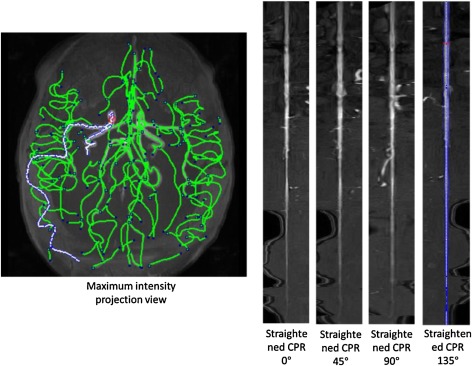A novel algorithm for refining cerebral vascular measurements in infants and adults
Li Chen, Stephen R. Dager, Dennis W.W. Shaw, Neva M. Corrigan, Mahmud Mossa-Basha, Kristi D. Pimentel, Natalia M. Kleinhans, Patricia K. Kuhl, Jenq-Neng Hwang, Chun Yuan
Highlights
• A vascular refinement algorithm is proposed to reduce measurement errors in intracranial vascular tracing.
• This algorithm uses straightened curved planar reformation that incorporates information from surrounding voxels along the artery.
• The reliability of the algorithm is demonstrated on simulated data and repeat scans from 5 adults and 5 full-term infants.
• This algorithm provides objective characterization of intracranial vascular features from magnetic resonance angiography.
Abstract
Background
Comprehensive quantification of intracranial vascular characteristics by vascular tracing provides an objective clinical assessment of vascular structure. However, weak signal or low contrast in small distal arteries, artifacts due to volitional motion, and vascular pulsation are challenges for accurate vessel tracing from 3D time-of-flight (3D-TOF) magnetic resonance angiography (MRA) images.
New Method
A vascular measurement refinement algorithm is developed and validated for robust quantification of intracranial vasculature from 3D-TOF MRA. After automated vascular tracing, centerline positions, lumen radii and centerline deviations are jointly optimized to restrict traces to within vascular regions in the straightened curved planar reformation (CPR) views. The algorithm is validated on simulated vascular images and on repeat 3D-TOF MRA acquired from infants and adults.
Results
The refinement algorithm can reliably estimate vascular radius and correct deviated centerlines. For the simulated vascular image with noise level of 1 and deviation of centerline of 3, the mean radius difference is below 15.3 % for scan-rescan reliability. Vascular features from repeated clinical scans show significantly improved measurement agreement, with intra-class correlation coefficient (ICC) improvement from 0.55 to 0.7 for infants and from 0.59 to 0.92 for adults.
Comparison with Existing Methods
The refinement algorithm is novel because it utilizes straightened CPR views that incorporate information from the entire artery. In addition, the optimization corrects centerline positions, lumen radii and centerline deviations simultaneously.
Conclusions
Intracranial vasculature quantification using a novel refinement algorithm for vascular tracing improves the reliability of vascular feature measurements in both infants and adults.
Keywords
Intracranial vasculature quantification, Vascular measurement refinement, Artery tracing, Vascular feature extraction, Multiplanar reformation, Vasculature mapping
DOI:
https://doi.org/10.1016/j.jneumeth.2020.108751
Link:
https://authors.elsevier.com/c/1a~gQbXTOx6Mo
